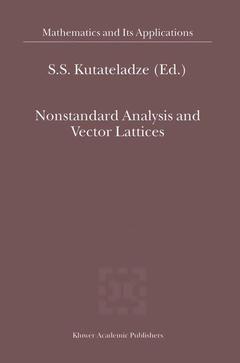Description
Nonstandard Analysis and Vector Lattices, Softcover reprint of the original 1st ed. 2000
Mathematics and Its Applications Series, Vol. 525
Coordinator: Kutateladze Semën Samsonovich
Language: English
Keywords
Nonstandard Analysis and Vector Lattices
Publication date: 10-2012
307 p. · 16x24 cm · Paperback
Publication date: 10-2012
307 p. · 16x24 cm · Paperback
Nonstandard analysis and vector lattices
Publication date: 10-2000
320 p. · Hardback
Publication date: 10-2000
320 p. · Hardback
Description
/li>Contents
/li>
Nonstandard methods of analysis consist generally in comparative study of two interpretations of a mathematical claim or construction given as a formal symbolic expression by means of two different set-theoretic models: one, a "standard" model and the other, a "nonstandard" model. The second half of the twentieth century is a period of significant progress in these methods and their rapid development in a few directions. The first of the latter appears often under the name coined by its inventor, A. Robinson. This memorable but slightly presumptuous and defiant term, non standard analysis, often swaps places with the term Robinsonian or classical non standard analysis. The characteristic feature of Robinsonian analysis is a frequent usage of many controversial concepts appealing to the actual infinitely small and infinitely large quantities that have resided happily in natural sciences from ancient times but were strictly forbidden in modern mathematics for many decades. The present-day achievements revive the forgotten term infinitesimal analysis which reminds us expressively of the heroic bygones of Calculus. Infinitesimal analysis expands rapidly, bringing about radical reconsideration of the general conceptual system of mathematics. The principal reasons for this progress are twofold. Firstly, infinitesimal analysis provides us with a novel under standing for the method of indivisibles rooted deeply in the mathematical classics.
1. Nonstandard Methods and Kantorovich Spaces.- § 1.1. Zermelo—Fraenkel Set Theory.- § 1.2. Boolean Valued Set Theory.- § 1.3. Internal and External Set Theories.- § 1.4. Relative Internal Set Theory.- § 1.5. Kantorovich Spaces.- § 1.6. Reals Inside Boolean Valued Models.- § 1.7. Functional Calculus in Kantorovich Spaces.- § 1.8. Lattice Normed Spaces.- § 1.9. Nonstandard Hulls.- § 1.10. The Loeb Measure.- § 1.11. Boolean Valued Modeling in a Nonstandard Universe.- § 1.12. Infinitesimal Modeling in a Boolean Valued Universe.- § 1.13. Extension and Decomposition of Positive Operators.- § 1.14. Fragments of Positive Operators.- § 1.15. Order Continuous Operators.- § 1.16. Cyclically Compact Operators.- References.- 2. Functional Representation of a Boolean Valued Universe.- § 2.1. Preliminaries.- § 2.2. The Concept of Continuous Bundle.- § 2.3. A Continuous Polyverse.- § 2.4. Functional Representation.- References.- 3. Dual Banach Bundles.- § 3.1. Auxiliary Results.- § 3.2. Homomorphisms of Banach Bundles.- § 3.3. An Operator Bundle.- § 3.4. The Dual of a Banach Bundle.- § 3.5. Weakly Continuous Sections.- References.- 4. Infinitesimals in Vector Lattices.- § 4.0. Preliminaries.- § 4.1. Saturated Sets of Indivisibles.- § 4.2. Representation of Archimedean Vector Lattices.- § 4.3. Order, Relative Uniform Convergence, and the Archimedes Principle.- § 4.4. Conditional Completion and Atomicity.- § 4.5. Normed Vector Lattices.- § 4.6. Linear Operators Between Vector Lattices.- § 4.7. *-Invariant Homomorphisms.- § 4.8. Order Hulls of Vector Lattices.- § 4.9. Regular Hulls of Vector Lattices.- § 4.10. Order and Regular Hulls of Lattice Normed Spaces.- § 4.11. Associated Banach—Kantorovich Spaces.- References.- 5. Vector Measures andDominated Mappings.- § 5.1. Vector Measures.- § 5.2. Quasi-Radon and Quasiregular Measures.- § 5.3. Integral Representations and Extension of Measures.- § 5.4. The Fubini Theorem.- § 5.5. The Hausdorff Moment Problem.- § 5.6. The Hamburger Moment Problem.- § 5.7. The Hamburger Moment Problem for Dominant Moment Sequences.- § 5.8. Dominated Mappings.- § 5.9. The Bochner Theorem for Dominated Mappings.- § 5.10. Convolution.- § 5.11. Boolean Valued Interpretation of the Wiener Lemma.- References.- Notation Index.
© 2024 LAVOISIER S.A.S.
These books may interest you

Nonstandard Methods of Analysis 105.49 €

The Foundations of Mathematics 89.02 €


